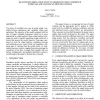Free Online Productivity Tools
i2Speak
i2Symbol
i2OCR
iTex2Img
iWeb2Print
iWeb2Shot
i2Type
iPdf2Split
iPdf2Merge
i2Bopomofo
i2Arabic
i2Style
i2Image
i2PDF
iLatex2Rtf
Sci2ools
100
Voted
WSC
2001
2001
Quantifying simulation output variability using confidence intervals and statistical process control
Two types of variability can occur in model output: variability between replications and variability within each replication. The objective of the model combined with the type of output variability determines which tool is more appropriate for output analysis. Many output analysis techniques are used to translate simulation model results into a format that answers the model objective. This paper compares two tools for output analysis: confidence intervals and statistical process control. Each tool quantifies a different type of variation from the model results. As such, statistical process control is applied beyond monitoring the consistency of run data. A supply chain example with one factory, multiple parts, and multiple distribution centers is used throughout the paper to illustrate these concepts.
Related Content
| Added | 31 Oct 2010 |
| Updated | 31 Oct 2010 |
| Type | Conference |
| Year | 2001 |
| Where | WSC |
| Authors | Amy Jo Naylor |
Comments (0)

